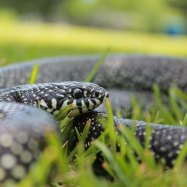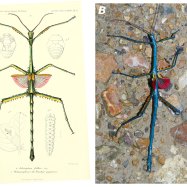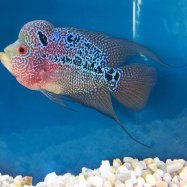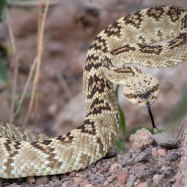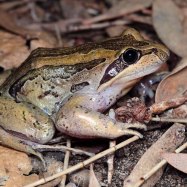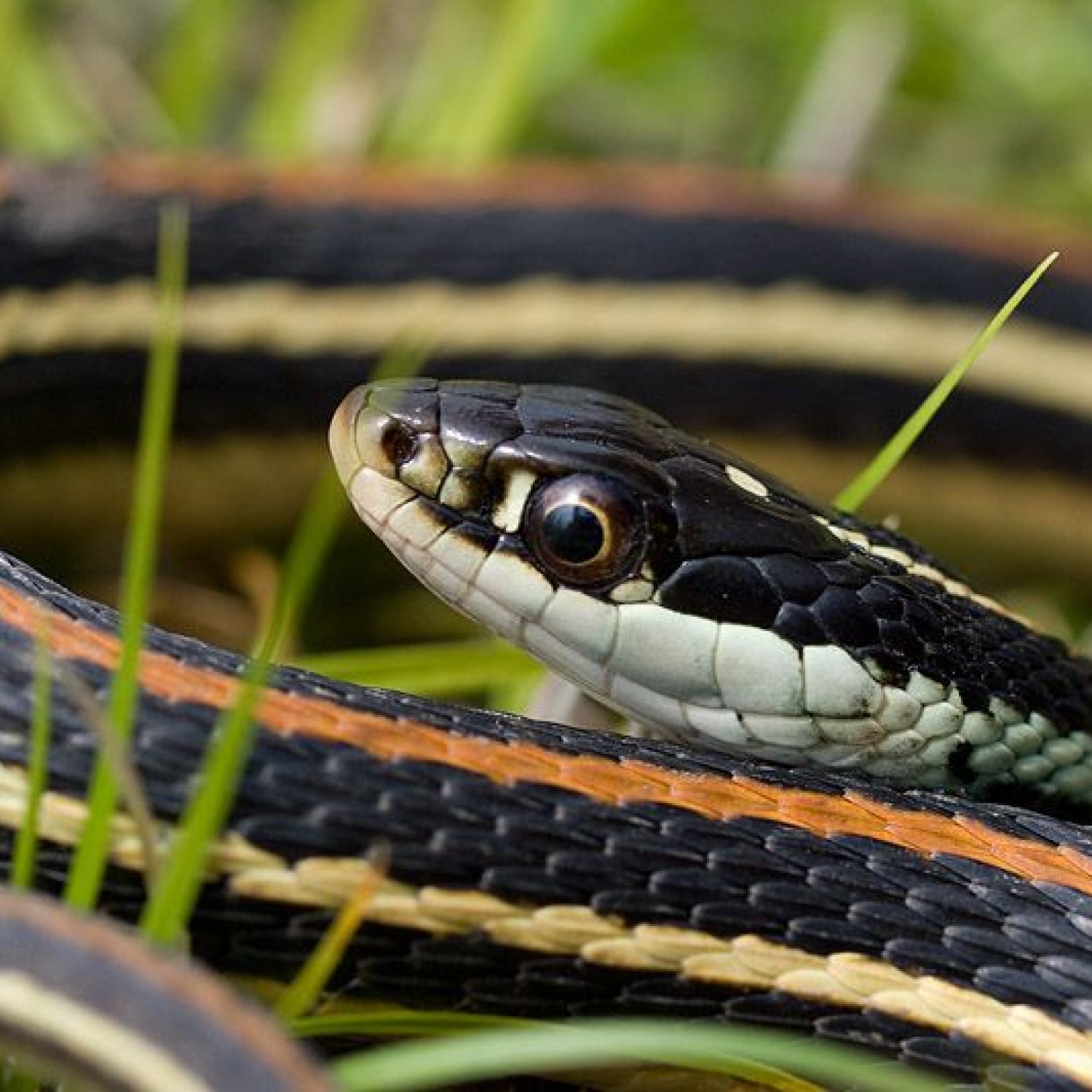
Texas Garter Snake
1.5 to 3.5 feet
The Texas Garter Snake, part of the Colubridae family, is a slender and elongated snake that can grow up to 3.5 feet in length. Found in Texas, this non-venomous snake is a popular choice for reptile enthusiasts due to its variety of colors, including orange, yellow, and black. However, it is important to remember that like all wild animals, the Texas Garter Snake should be respected and left alone in its natural habitat. #TexasGarterSnake #Colubridae #TexasWildlife
Animal Details Summary:
Common Name: Texas Garter Snake
Kingdom: Animalia
Habitat: Wetlands, streams, rivers, ponds, lakes
The Colorful and Misunderstood Texas Garter Snake
Within the lush, green wetlands of Texas and northeastern Mexico, a brightly colored serpent slithers through the murky waters. Its slender and elongated body moves gracefully through the water as it hunts for its next meal. This is the Texas Garter Snake, a unique and often misunderstood reptile that calls the United States its home.Scientifically known as Thamnophis sirtalis annectens, the Texas Garter Snake is a common name given to this fascinating species Texas Garter Snake. Found in the kingdom Animalia, phylum Chordata, and class Reptilia, these snakes belong to the order Squamata and the family Colubridae. Their habitat primarily includes wetlands, streams, rivers, ponds, and lakes, making them excellent swimmers and hunters. As carnivores, they feed on a variety of prey, including fish, frogs, small mammals, and even other snakes.
The geographical distribution of these snakes is limited to Texas and northeastern Mexico. They can be found in various areas within Texas, but their country of origin is the United States of America. Within the state, they can be found in a variety of locations, but they are particularly common in the eastern and central regions, where there is abundant water.
One of the most striking features of the Texas Garter Snake is its coloration. These snakes have a black body with two contrasting yellow stripes running down each side. The black and yellow coloration serves as a warning to potential predators that they are not to be messed with Tibetan Fox. However, these snakes are not venomous, and their main defense mechanism is to release a strong-smelling musk when threatened.
In terms of physical appearance, the Texas Garter Snake is thin and elongated, with a smooth and shiny body. They have small, beady eyes and a forked tongue that helps them detect their surroundings and prey. They also have small, sharp teeth, which are helpful in catching and consuming their prey.
The average length of a Texas Garter Snake is between 1.5 to 3.5 feet, making them relatively small compared to other types of snakes. However, their small size does not make them any less of a predator. They use their streamlined body to swiftly move through water and their excellent camouflage to hide amongst the reeds and vegetation in their habitat.
Despite their intimidating appearance, Texas Garter Snakes are generally docile and non-aggressive towards humans. They are not known to attack humans unless provoked. However, they do play a crucial role in maintaining the balance of the ecosystem. As predators, they help control the population of other animals, such as fish and frogs, who would otherwise overpopulate their habitat.
One of the biggest threats to the Texas Garter Snake is habitat loss. Due to urbanization and development, many wetlands and other bodies of water are being drained and destroyed, leaving these snakes with limited places to live and hunt. Chemical runoff from farms and industries also poses a danger to the overall health and population of these snakes.
Another threat to the Texas Garter Snake is the illegal pet trade. These snakes are often captured and sold as pets, leading to a decline in their wild population. Unlike other types of garter snakes, the Texas Garter Snake is not an easy species to care for in captivity, and many of them end up dying due to improper care.
To protect these snakes from these threats, various organizations and institutions in Texas, such as the Texas Parks and Wildlife Department, have implemented laws and regulations to conserve their population. They also work towards restoring and preserving the wetland habitats where these snakes reside.
If you ever come across a Texas Garter Snake in its natural habitat, it is best to admire it from a distance and not try to touch or catch it. As with any wild animal, it is essential to respect their space and allow them to live their lives without interference.
In conclusion, the Texas Garter Snake is a fascinating and unique reptile that is an integral part of the ecosystem of Texas and northeastern Mexico. Its colorful appearance, impressive swimming abilities, and vital role in the environment make it a significant species that deserves our protection and conservation efforts. So, the next time you come across a Texas Garter Snake, remember to appreciate its beauty and leave it be in its natural home.

Texas Garter Snake
Animal Details Texas Garter Snake - Scientific Name: Thamnophis sirtalis annectens
- Category: Animals T
- Scientific Name: Thamnophis sirtalis annectens
- Common Name: Texas Garter Snake
- Kingdom: Animalia
- Phylum: Chordata
- Class: Reptilia
- Order: Squamata
- Family: Colubridae
- Habitat: Wetlands, streams, rivers, ponds, lakes
- Feeding Method: Carnivorous
- Geographical Distribution: Texas and northeastern Mexico
- Country of Origin: United States of America
- Location: Texas
- Animal Coloration: Black body with yellow stripes on each side
- Body Shape: Slender and elongated
- Length: 1.5 to 3.5 feet
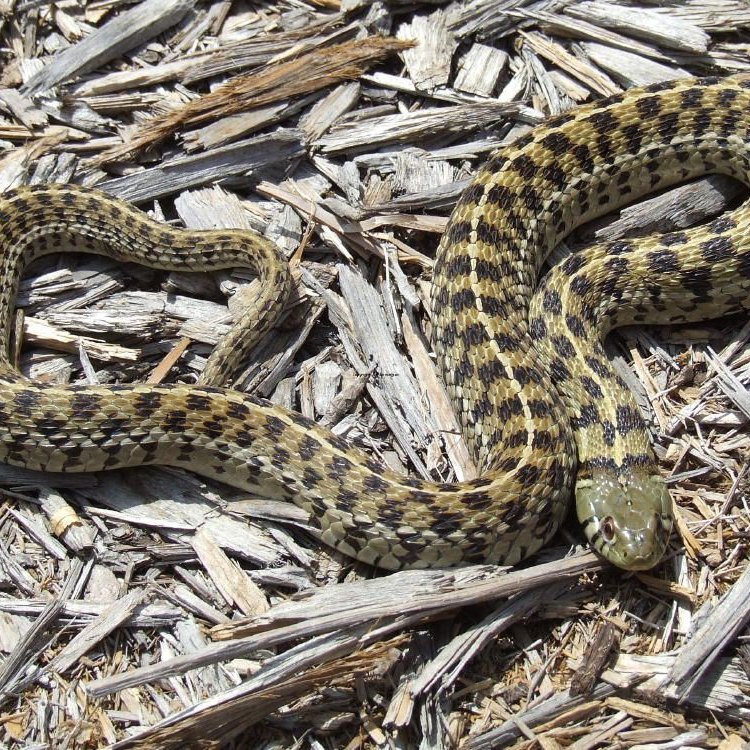
Texas Garter Snake
- Adult Size: Medium-sized snake
- Average Lifespan: 10 to 12 years
- Reproduction: Sexual
- Reproductive Behavior: Mate in spring
- Sound or Call: No specific sound or call
- Migration Pattern: No specific migration pattern
- Social Groups: Solitary
- Behavior: Mostly diurnal and semi-aquatic
- Threats: Loss of habitat, pollution, predation
- Conservation Status: Least Concern
- Impact on Ecosystem: Important predator of small animals
- Human Use: Occasionally kept as pets
- Distinctive Features: Yellow stripes on black body
- Interesting Facts: Texas Garter Snakes are capable of releasing a foul-smelling musk as a defense mechanism.
- Predator: Birds of prey, mammals, larger snakes
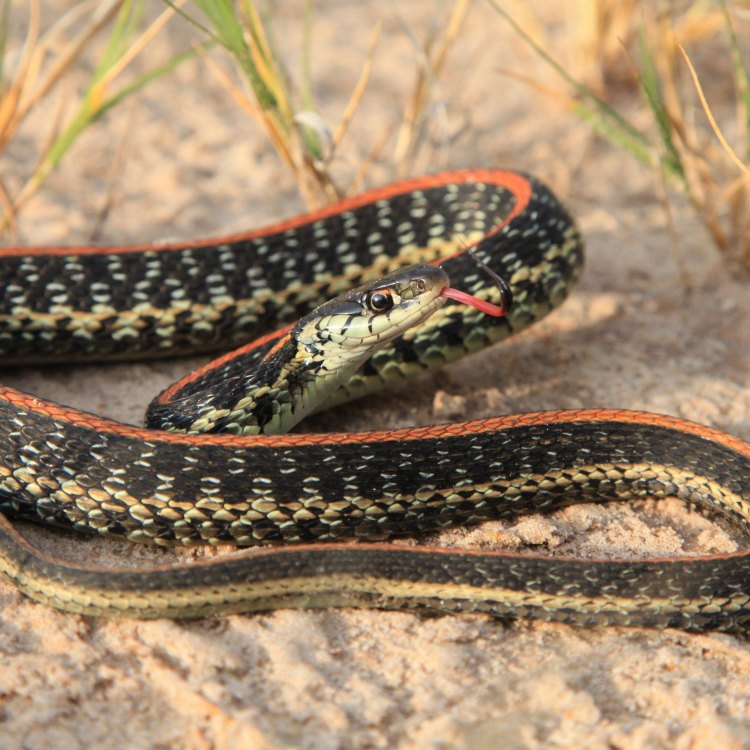
Thamnophis sirtalis annectens
The Alluring and Unique Features of the Texas Garter Snake
When most people think of snakes, they may imagine large and deadly predators like the anaconda or the cobra. However, not all snakes are of such a formidable nature. Some snakes, like the Texas Garter Snake, possess a unique set of features that make them stand out in the animal kingdom.The Texas Garter Snake, also known as the Thamnophis sirtalis annectens, is a medium-sized snake found in the United States, primarily in the state of Texas PeaceOfAnimals.Com. This snake is part of the Colubridae family, which includes over 1,700 species of non-venomous snakes.
In this article, we will delve into the fascinating world of the Texas Garter Snake, exploring its physical characteristics, behavior, threats, and impact on the ecosystem, as well as its interesting and distinctive features.
Average Lifespan and Reproductive Behavior
On average, the Texas Garter Snake has a lifespan of 10 to 12 years in the wild. However, they have been known to live up to 20 years in captivity. As a sexually-reproducing species, the Texas Garter Snake mates in the spring, right after emerging from hibernation.The female snakes give birth to live young, and a litter can consist of up to 40 babies. These snakes reach sexual maturity at around two years of age, but they may continue to grow until they reach their full adult size.
Physical Characteristics and Behavior
The Texas Garter Snake is a medium-sized snake, reaching an average length of around two feet, with the record being just over three feet. They have a long and slender body with a flattened head and a pointed snout Tiger Muskellunge. Their bodies are covered in smooth scales, and their coloration varies from shades of black, brown, and olive green.One of the most distinctive features of the Texas Garter Snake is the bright yellow stripes that run down its body, usually outlined in black. This pattern gives the snake its unique and eye-catching appearance. These stripes also serve as a warning to predators, as they signal that the snake may be venomous. However, the Texas Garter Snake is non-venomous, and its bright colors are only a form of camouflage.
These snakes are mostly diurnal, meaning they are active during the day, but they may also come out at night in water-rich environments. The Texas Garter Snake is also a semi-aquatic species, preferring to live near a water source such as streams, ponds, and marshes.
Threats and Conservation Status
Like many other species, the Texas Garter Snake is facing threats to its survival. The most significant threat to their population is the loss of habitat. As human development continues to encroach on their environment, these snakes have fewer places to live and hunt for food.Pollution is another serious threat to the Texas Garter Snake. As these snakes are semi-aquatic, they are highly sensitive to chemical and environmental changes in their habitat. Pollutants can affect their health and reproductive capabilities, leading to a decline in their population.
Predation is also a significant threat to the Texas Garter Snake, with birds of prey, mammals, and larger snakes being their main predators. These snakes do have a defense mechanism in the form of their foul-smelling musk, but it is not always effective against larger predators.
Despite these threats, the Texas Garter Snake is currently listed as "Least Concern" on the IUCN Red List of Threatened Species. This status is a result of its wide distribution and relatively stable population. However, continued efforts are necessary to maintain a healthy population of these snakes and protect their habitats.
Impact on the Ecosystem
The Texas Garter Snake plays an essential role in its ecosystem as an important predator of small animals. As a non-venomous snake, it mainly feeds on insects, small rodents, frogs, and fish. By controlling these populations, the Texas Garter Snake helps to maintain a balanced ecosystem.Their presence in the ecosystem also serves as a food source for predators, and their habitat provides shelter for other organisms. The well-being of the Texas Garter Snake is crucial to the health and balance of its ecosystem.
Human Use and Interesting Facts
Occasionally, the Texas Garter Snake is kept as a pet by snake enthusiasts. They are relatively easy to care for, but they require specialized diets and a suitable habitat that mimics their natural environment.Aside from their distinctive physical features and important role in the ecosystem, the Texas Garter Snake also has some interesting facts that make it stand out. One of these facts is their ability to release a foul-smelling musk as a defense mechanism, similar to skunks. This musk serves as a warning to potential predators and can be quite potent and difficult to remove.
In Conclusion
The Texas Garter Snake may not be as famous as some of its larger and more menacing counterparts, but it possesses a unique set of features and qualities that make it a fascinating species. From its distinct yellow stripes and semi-aquatic nature to its important role in the ecosystem, the Texas Garter Snake is a vital member of the animal kingdom.However, their populations are facing threats, and it is important to raise awareness about their conservation. By understanding and appreciating these creatures, we can work towards preserving their habitats and ensuring their continued survival in the wild. After all, every species, no matter how small, plays a crucial role in maintaining a balance in our delicate ecosystem.
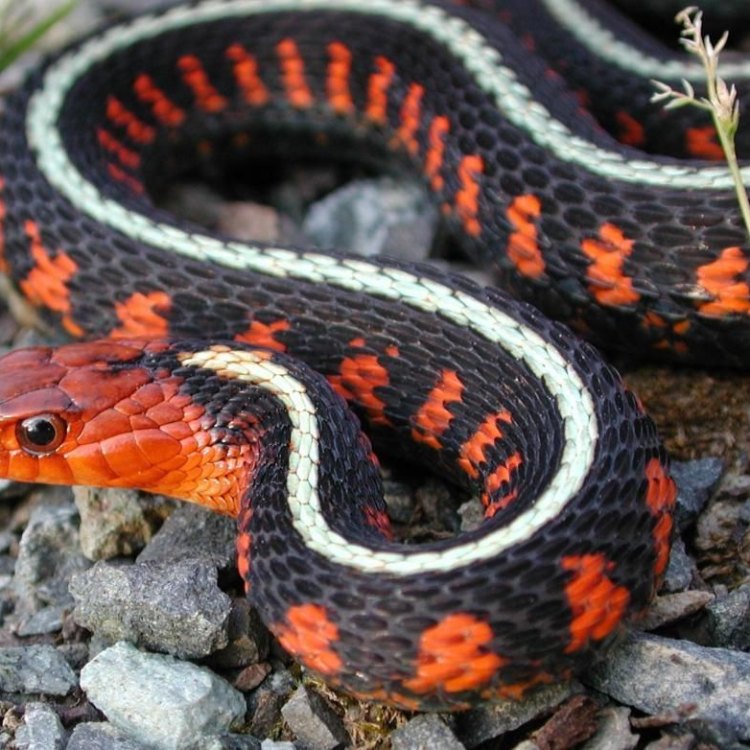
The Colorful and Misunderstood Texas Garter Snake
Disclaimer: The content provided is for informational purposes only. We cannot guarantee the accuracy of the information on this page 100%. All information provided here may change without prior notice.


